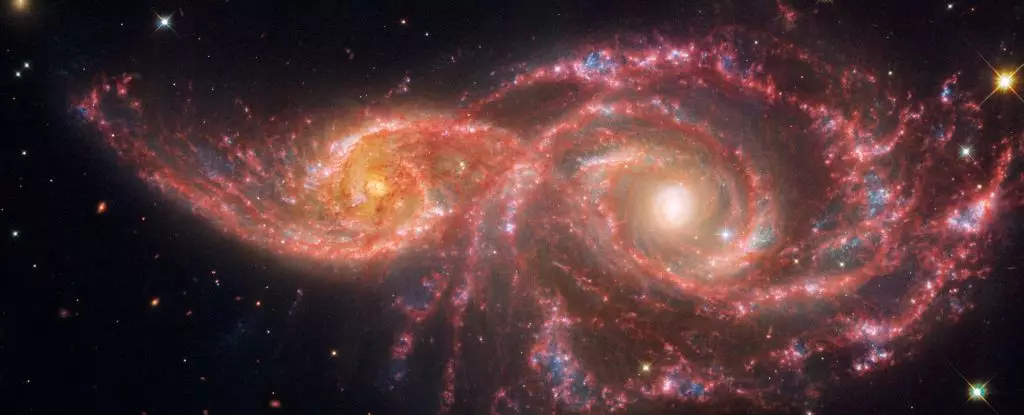The cosmos is a tapestry of extraordinary phenomena, each thread woven with intricate detail and purpose. Among these wonders are galaxies, vast collections of stars, gas, dust, and dark matter, engaging in a celestial ballet that spans eons. Friedrich Nietzsche’s haunting assertion, “If you gaze for long into an abyss, the abyss gazes also into you,” can be reinterpreted in the context of our exploration of the universe. As we examine cosmic events, particularly the intergalactic dance of galaxies like NGC 2207 and IC 2163, not only do we observe the majesty of the cosmos, but we also see reflections of our understanding, aspirations, and even fears of the universe’s immense scale.
The mesmerizing images captured by the Hubble Space Telescope and the James Webb Space Telescope reveal a striking spectacle: two galaxies in the throes of collision. At a breathtaking distance of approximately 80 million light-years from Earth, NGC 2207 and IC 2163 are not merely two swirling masses in the void; they represent an age-old narrative of cosmic interaction. Unlike what one might envision during a typical collision, these galaxies do not meet in a cataclysmic explosion; rather, they embark on a prolonged and graceful cosmic waltz. As they traverse through each other’s gravitational fields, they experience a pull that sparks profound changes both internally and externally.
This cosmic engagement initiates a long-term transformation of the galactic structure. The merging process is gradual; NGC 2207 and IC 2163 have already brushed against one another in the past, with their current interaction being a second rendezvous of sorts. The eventual fate of this galactic union is the birth of a singular larger galaxy, complete with its own supermassive black hole at its nucleus. However, this amalgamation is not simply a merging of matter; it reflects the intricate dance of creation and destruction that governs the universe.
One of the most astonishing consequences of this galactic collision is the fervent rate of star formation spurred by their gravitational embrace. As they spiral in their celestial duet, the interstellar gas clouds within both galaxies are subjected to intense shocks and compressions. When these dense regions of gas reach critical thresholds, they collapse under their own gravity, leading to the genesis of new stars. This process occurs at an astonishing pace in NGC 2207 and IC 2163, yielding stellar births at rates that dwarf the more tempered star generation seen in our own Milky Way, which produces only a handful of stars akin in mass to our Sun annually.
Furthermore, the cycle of star formation is inextricably linked with the violent deaths of massive stars that emerge within these stellar nurseries. Such stars, with their brief but radiant lives, end in spectacular supernovae, which in turn shock the surrounding gas, perpetuating the cycle of birth, life, and death. Regions rich in stellar birth can be observed in vibrant, sparkling blue hues within Hubble’s ultraviolet imagery, juxtaposed against the intricate web-like structures of dust that JWST captures in mid-infrared.
As we delve deeper into the celestial mechanics at play between NGC 2207 and IC 2163, we inevitably find parallels between these cosmic events and human existence. The universe, vast and impersonal, seems to mirror the struggles, triumphs, and inevitable transformations of life on Earth. The collision of these galaxies invites us to reflect on our place within the cosmos, integrating Nietzsche’s poignant contemplation with the beauty and chaos of the night sky.
In contemplating the complexities of galactic formation and destruction, we gain insights into the fundamental nature of existence itself. The life cycles of stars and the eventual clashes of great galactic bodies remind us that creation often emerges from chaos. Perhaps the abyss isn’t merely an absence of meaning; it may also be a profound source of creativity and insight into our own existence.
In sum, the merging of NGC 2207 and IC 2163 transcends mere observational astronomy; it invites us to ponder deeper philosophical questions that bridge our understanding of the universe with our own experiences. As we gaze at the cosmos, we realize the abyss indeed gazes back, offering glimpses into the astonishing, dynamic, and sometimes chaotic workings of the universe. In this intricately woven tapestry of existence, we find not only celestial wonders but also echoes of our shared human experience. In exploring the cosmos, we unravel not just the mysteries of galaxies but also gain a richer understanding of ourselves and our place in this grand, expansive universe.


Leave a Reply